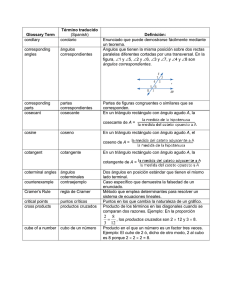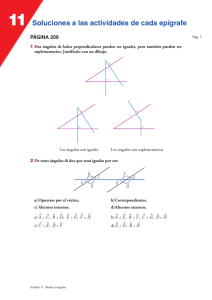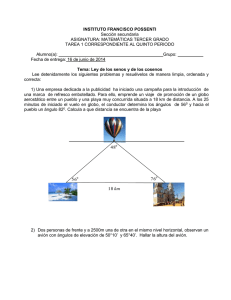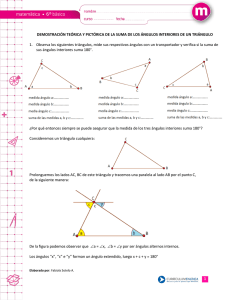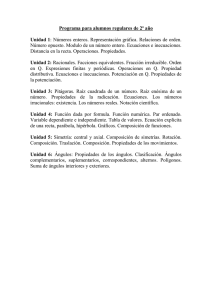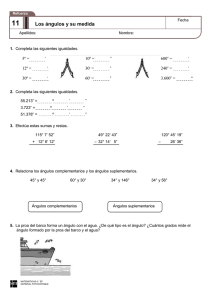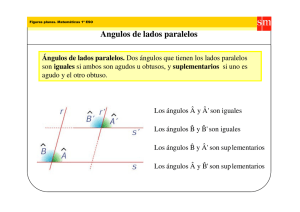optimizacion de una bomba inteligente para su posterior
Anuncio
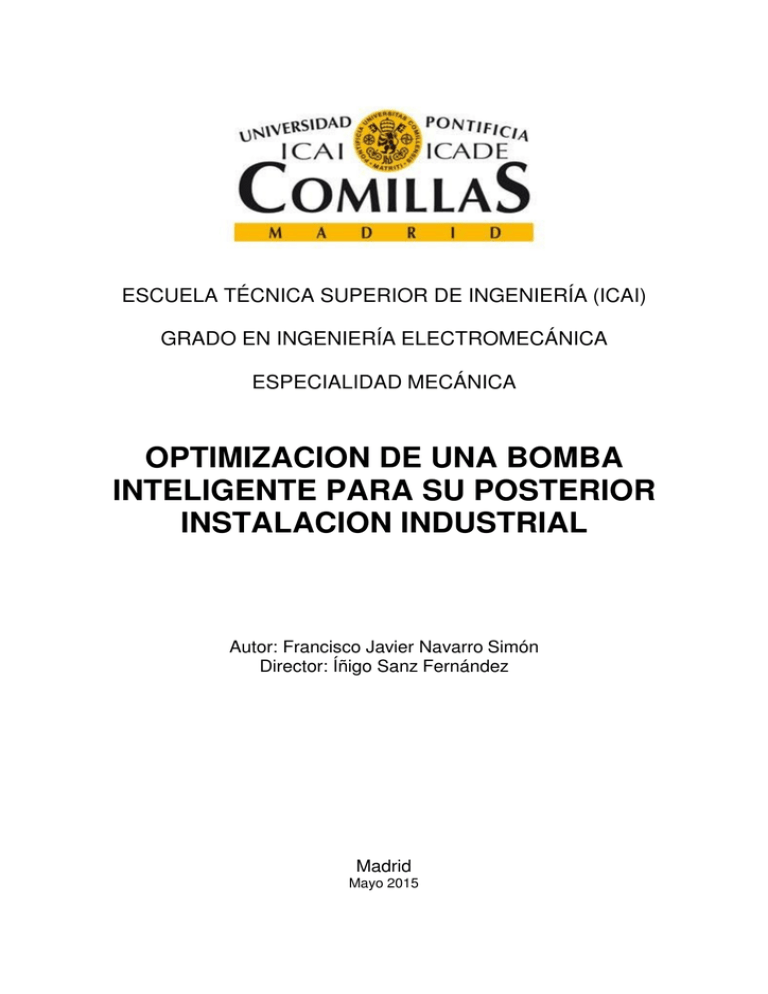
ESCUELA TÉCNICA SUPERIOR DE INGENIERÍA (ICAI) GRADO EN INGENIERÍA ELECTROMECÁNICA ESPECIALIDAD MECÁNICA OPTIMIZACION DE UNA BOMBA INTELIGENTE PARA SU POSTERIOR INSTALACION INDUSTRIAL Autor: Francisco Javier Navarro Simón Director: Íñigo Sanz Fernández Madrid Mayo 2015 OPTIMIZACION DE UNA BOMBA INTELIGENTE PARA SU POSTERIOR INSTALACION INDUSTRIAL Autor: Javier Navarro Simón Director: Iñigo Sanz Fernández Entidad colaboradora: ICAI – Universidad Pontificia Comillas Resumen del Proyecto El proyecto desarrolla el estudio de los ángulos de los álabes de un rodete y un difusor, así como el diseño de la instalación de bombeo de agua para el suministro a un edificio de oficinas cuya actividad principal es diurna. El proyecto se estructura en dos partes. La primera es el estudio detallado de los ángulos de los álabes del rodete y del difusor, para encontrar la combinación de éstos más óptima. La segunda parte es el diseño de la instalación de bombeo de la bomba. El estudio teórico se realiza para los ángulos β1, β2 y α4, ya que son los ángulos más importantes del rodete (junto con el ángulo α1). Dado que el año 2014, Alejandro Hermosin realizó el estudio de todo el rodete, se ha decidido centrar nuestro estudio en los dos ángulos mencionados del rodete y el tercero del difusor, tomando el ángulo α1 con un valor constante de 89,5º. Los ángulos β, son los que forman el vector velocidad relativa del fluido junto con el vector velocidad lineal del rodete, siendo el subíndice 1 el que indica que es a la entrada del rodete y el 2 a la salida de éste. El ángulo α4 es el ángulo del vector velocidad del fluido a la salida del difusor, siendo su antecesor (a la entrada del difusor) el indicado con el subíndice 3. En nuestro caso, hemos elegido un ángulo α1 como constante de valor 89,5º. Esto hace que los ángulos α2 y α3 sean dependientes, y que los tres ángulos que estudiamos puedan tener distintos valores (son parámetros de entrada o lo que es lo mismo, ángulos constructivos de la bomba). El estudio teórico de los ángulos se realiza de la forma que se resume a continuación. En primer lugar, se realiza el estudio teórico de cómo varían los parámetros de rendimiento potencia y altura en función de los ángulos, haciendo variar uno de ellos y dejando los otros dos constantes. Con esto, se consigue ver cómo varían esos tres parámetros (que son aquellos parámetros que luego se tendrán en cuenta a la hora de elegir la combinación más óptima) en función de cada uno de los ángulos. Para la realización de este cálculo, se ha utilizado el software de cálculo Matlab, con el cual a partir de un programa con bucles se ha conseguido cubrir todas las combinaciones posibles de los tres ángulos, y obteniendo al finalizar el programa los tres parámetros que se han mencionado anteriormente (potencia, rendimiento y altura) que serán los que se utilizaran para elegir la combinación más óptima. Una vez terminada esta primera parte acerca del estudio teórico, se comienza con el estudio de la instalación de bombeo. La instalación de bombeo se realizará para el edificio de oficinas de una empresa situada en Méndez Álvaro en la calle Retama 3 (Madrid). Se realizará una instalación hidráulica tal que impulse el agua desde el nivel cero (nivel del suelo, que es desde donde llega el agua del Canal de Isabel II) hasta la cima del edificio, desde donde se dejará caer por gravedad a cada una de las plantas. El desarrollo de esta instalación se realizará mediante los siguientes pasos: • • • • • Estimación del volumen del pozo de bombeo Selección de tuberías Selección de válvulas Selección de la bomba (en nuestro caso, motobomba) Determinación de los niveles de arranque y parada del pozo de bombeo El cálculo del volumen del pozo de bombeo se ha realizado mediante el software PSD de ABS – SULZER, con el cual se ha obtenido un volumen útil del pozo de bombeo de 0,4 m3. Una vez calculado el pozo de bombeo, se procede a la elección de las tuberías y válvulas. Para las tuberías se ha elegido el material Polietileno (PE), ya que sus características de baja rugosidad y bajo precio concuerdan bien con las necesidades de nuestro proyecto (además, el código del Canal de Isabel II establece que este material es el más indicado para este tipo de instalaciones). Las válvulas elegidas son de dos tipos: la primera es una válvula de compuerta elástica para dirigir el fluido por el sistema de tuberías adecuado, y la segunda es una válvula de bola (anti retorno) para impedir que el fluido circule por la bomba en sentido contrario. Al igual que en el caso de las tuberías, el código del Canal de Isabel II establece que estos tipos de bombas son las más indicadas para nuestra instalación. Por último, se procede a la elección de la bomba. La bomba seleccionada deberá cumplir con las necesidades de caudal (establecido por el Canal de Isabel II para edificios de oficinas) y de altura (altura del edificio junto con las pérdidas de carga que producen las tuberías y la geometría de la instalación). Por lo tanto, el punto de trabajo será un caudal de 6,63 l/s y una altura de 100,514 m (contando con las pérdidas). Utilizando el software ABS ABSEL, se elige la bomba NK 65/40 – 26 C 50 Hz para nuestra instalación. La memoria del proyecto se realizó conjuntamente con el anexo Cálculos, donde se han explicado los cálculos realizados durante el proyecto. El anexo Resultados muestra parte de los resultados que se obtuvieron tras el barrido de ángulos de la primera mitad del proyecto. A continuación se realizó el presupuesto del proyecto donde se tuvo en cuenta el coste de compra de los materiales y maquinaria, coste de la instalación, coste energético, costes de operación, costes de mantenimiento, costes por impactos medioambientales, costes por avería y costes por retirada. Con todo esto, el presupuesto total de nuestro proyecto asciende a la cifra de 155.372,98 €. Por último, se añaden también los pliegos de condiciones técnicas y económicas que indican las condiciones técnicas y económicas que debe de cumplir la ejecución del proyecto. OPTIMIZATION OF AN INTELLIGENT PUMP FOR FURTHER INDUSTRIAL INSTALLATION PROYECT ABSTRACT The project develops the study of the angles of the blades of an impeller and a diffuser, as well as the design of the water pumping facility to supply an office building with daily main activity. The Project is structured in two sections. The first one focuses on the detailed study of the angles of the blades of the impeller and the diffuser, to reach the optimum combination of them. The second part is the design of the pumping facility. The theoretical study is performed for the angles β1, β2 y α4, as these are the most relevant ones for the impeller (together with the α1 angle). As during 2014, Alejandro Hermosín developed the study of the whole impeller, it is decided here to focus the study on the two mentioned angles of the impeller and on the third mentioned for the diffuser, taking the value for α1 to be 89,5º. The β angles are formed by the relative velocity vector of the fluid with the lineal velocity vector of the impeller, where subscript 1 correspond to the entrance of the impeller and subscript 2 its exit. α4 angle is formed by the velocity vector of the fluid at the exit of the diffuser, and the angle at the entrance of the diffuser is marked with the subscript 3. In our case, an α1 constant angle has been selected to be 89,5º. This makes α2 and α3 angles to be dependent, and allows that every three angles under study to take different values (they are input parameters or in other words, constructive angles for the pump). The theoretical study of the angles is performed as summarized below. As a first step, the theoretical study of the variation of the power performance and height is carried out as a function of the angles, letting one of them vary and the rest being constant. This shows the variation of these three parameters (they will be taken into account later to choose de optimum combination) as a function of every angle. For this calculation, Matlab software has been applied. Matlab has calculated with loops all the potential combination among the three angles and getting as results the three parameters (power, performance and height). These three parameters will be used for the selection of the optimum combination. Once this first part is concluded, the study of the pumping facility is started. The facility is designed for and offices building sited in Méndez Álvaro, Retama 3rd Street (Madrid). The hydraulic installation will pump water from the ground floor (where Canal de Isabel II provision is sited) to the top of the building, from where water will be distributed to every floor by the impulse of gravity. The development of this facility will be done through the following steps: • • • • • Estimation of the pumping well volume Pipes selection Valves selection Selection of a pump (motorpump for this case) Determination of the start and stop levels for the pumping well The calculation of the pumping well volume has been carried out with PSD (ABS – SULZER) software. The usable volume for the pumping well has been calculated to be 0,4 m3. After obtaining this value, the selection of pipelines and valves is done. Polyethylene (PE) pipeline has been chosen based on its low rugosity and low cost, properties that fit well for the need of this project. Besides this, Canal de Isabel II establishes that this material is the most adequate one for this kind of facilities. There are two kinds of chosen valves: the first one is the elastic gate valve, which directs the fluid through the adequate pipes system; the second valve is a ball valve (check valve) to avoid the fluid to flow through the valve in the opposite direction. Analogous to the pipelines, Canal de Isabel II establishes that both pumps are the most adequate for this facility. Finally, the selection of the pump is carried out. The selected pump shall comply with the flow needs (established by Canal de Isabel II for offices buildings) and the height (real height of the building, adding the load loss due to pipelines themselves and the facility geometry). Hence, the working point will provide for a flow of 6,63 l/s and 100,514 m height (load loss added). ABS ABSEL software is used for the pump selection, being the model named as NK 65/40 – 26 C 50 Hz the one selected for this facility. The project memory has been elaborated in parallel with the annex of Calculations. This annex shows the calculations performed. The Results annex gives partial results obtained after the combinations of the first half of the project. The budget for the Project has been estimated taking into account the cost of materials, machinery, cost of the facility, energy cost, operational cost, maintenance cost, environmental impact cost, breakdown cost and withdrawal cost. All considered, the total budget estimation is given to be 155.372,98 €. To conclude with the documentation, the technical and economical conditions specifications for the project are attached.
